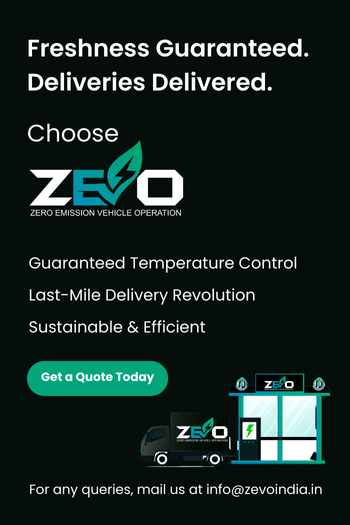The Future of Refrigerated Last-Mile Delivery In 2024

Akshay Sharma
CEO's Office @ZEVO
Ever wonder how that perfectly ripe avocado or those life-saving medications get delivered straight to your door?
It’s all thanks to the complex world of last-mile delivery. This final leg of a product’s journey is crucial, but keeping things fresh (literally!) can be a challenge.
Imagine a grocery delivery where your lettuce arrives wilted, or worse, your medicine loses its potency during transport.
The demand for these deliveries is skyrocketing. According to eMarketer (eMarketer, 2022), global retail e-commerce sales will surpass $5 trillion for the first time in 2022, accounting for more than a fifth of overall retail sales.
And by 2025, total spending will exceed $7 trillion, despite slowing growth. This boom is driven by busy professionals, tech-savvy consumers, and the ever-growing need for convenience. But for businesses like yours, ensuring temperature-sensitive products like groceries, pharmaceuticals, and even restaurant meals arrive in pristine condition adds a layer of complexity.
This is where refrigerated last-mile delivery comes in. It’s the hero behind those crisp vegetables and perfectly chilled medicines. But what innovations are on the horizon to keep pace with our ever-growing demands for speed, affordability, and sustainability?
Curious about how emerging technologies like electric vehicles, drone deliveries, and self-driving trucks can revolutionize refrigerated last-mile delivery? Dive deeper into this blog to explore these advancements, their potential benefits and limitations, and how they might shape the future of getting fresh and essential goods right to your doorstep.
Emerging Technologies for Refrigerated Last-Mile Delivery:
Electric Vehicles with Refrigerated Compartments:
Electric vehicles (EVs) are emerging as a sustainable solution for refrigerated last-mile deliveries. Here’s how:
- Sustainable Champion: EVs eliminate tailpipe emissions, contributing to cleaner air and a reduced carbon footprint. This is particularly beneficial in environmentally conscious cities with stricter regulations.
- Range and Recharge: While range limitations exist for EVs, battery technology advancements are constantly increasing their reach. Currently, EVs excel in shorter routes and urban deliveries. Additionally, the development of charging infrastructure is making it easier and more convenient to top up an EV on the go.
- Urban Delivery Advantage: Imagine a quiet, eco-friendly delivery van navigating city street. EVs offer this very benefit! Their quiet operation minimizes noise pollution, making them ideal for urban environments. Furthermore, their size and maneuverability allow them to navigate congested areas with ease.
Drone Deliveries with Temperature Control:
Drone deliveries with temperature control hold immense potential for revolutionizing last-mile delivery in urban areas. Let’s explore the possibilities:
- Speed and Convenience: Imagine receiving that urgent medication or last-minute meal ingredient within minutes! Drone deliveries offer significant time savings, especially in congested cities, by bypassing traffic congestion.
- Regulation and Safety: Safety and regulations are still evolving for drone deliveries. Addressing concerns about airspace management, noise levels, and security is crucial for wider adoption.
- Time-Sensitive Deliveries: Drone deliveries can be a game-changer for time-sensitive items like medical supplies or blood samples. Their speed and agility can make a significant difference in critical situations.
- Self-Driving Refrigerated Trucks:
Self-driving refrigerated trucks promise to transform long-haul deliveries:
- Efficiency on Autopilot: Imagine optimized routes, reduced driver fatigue, and a smoother delivery process – all powered by autopilot technology. Self-driving trucks hold the potential to significantly improve efficiency and address labor shortages in the logistics industry.
- Regulations and Public Acceptance: Extensive testing and safety measures are essential before self-driving trucks become commonplace. Regulations and public trust need to catch up with this futuristic concept.
- Long-Haul Applications: Self-driving trucks are best suited for long-distance deliveries on highways. Their potential to streamline long-haul refrigerated transport can significantly improve efficiency and reduce costs throughout the supply chain.
Solid-State Refrigeration: A Potential Game Changer?
While electric vehicles, drones, and self-driving trucks dominate the conversation around future delivery solutions, another technology quietly waits in the wings: solid-state refrigeration. This innovative approach utilizes the Peltier effect, where passing an electric current through a specific material creates a temperature difference on either side. Essentially, these thermoelectric coolers act like miniature heat pumps, offering several potential advantages for last-mile delivery:
Advantages of Solid-State Refrigeration:
- Reliable and Durable: Unlike traditional refrigeration systems with compressors and moving parts, solid-state technology has no such components. This translates to fewer breakdowns, higher reliability, and potentially lower maintenance costs.
- Eco-Friendly Choice: Solid-state systems eliminate the need for harmful refrigerants like Freon, contributing to a more sustainable future. This is particularly attractive for environmentally conscious businesses and regulations that are increasingly restricting the use of these chemicals.
- Compact and Lightweight: Solid-state coolers are smaller and lighter than traditional compressors. This makes them ideal for integrating into smaller compartments, potentially revolutionizing drone deliveries or enabling efficient cooling in tight spaces within delivery vehicles.
- Whisper-Quiet Operation: Noise pollution is a growing concern in urban areas. Solid-state coolers operate silently, making them a welcome addition to delivery fleets navigating city streets.
- Precise Temperature Control: Unlike traditional systems that struggle with maintaining consistent temperatures, solid-state coolers offer precise control. This is crucial for ensuring the quality and safety of temperature-sensitive items like medications or specific food products.
- Improved Energy Efficiency: While generally considered more efficient than traditional methods, solid-state technology can have higher power consumption, especially for large-scale applications. However, ongoing advancements in materials and design are continuously improving energy efficiency.
Limitations to Consider:
Despite the exciting possibilities, solid-state refrigeration still faces some limitations:
- Scaling Challenges: Currently, the technology isn’t suitable for large-scale applications like cooling entire trucks. However, advancements may address this limitation in the future.
- Cost Constraints: Solid-state coolers are currently more expensive than traditional systems. This limits their widespread adoption, particularly for large-scale applications, until production costs decrease.
Solid-state refrigeration is a promising technology with the potential to revolutionize how we keep things cool during last-mile delivery. While limitations exist, its advantages in terms of reliability, sustainability, and precise temperature control make it a technology worth watching. As research and development continue, solid-state refrigeration could become a game-changer in the future of chilled deliveries.
Beyond the Technology: Addressing Challenges and Opportunities
While these emerging technologies offer exciting possibilities, integrating them into existing delivery infrastructure presents challenges that need to be addressed.
- Infrastructure Integration: Transitioning from traditional delivery methods to electric vehicles, drones, or self-driving trucks necessitates adapting existing logistics networks. This might involve optimizing routes, developing charging infrastructure for EVs, or creating dedicated landing zones for drone deliveries. Training for personnel to operate and maintain these new technologies will also be crucial.
- Regulations and Safety: Safety is paramount, especially for technologies like drones and self-driving vehicles. Clear regulations and robust safety measures are essential to ensure public trust and prevent accidents. Collaboration between technology companies, policymakers, and regulatory bodies will be key in establishing these frameworks.
- Collaboration is Key: The successful adoption of these technologies hinges on collaboration. Technology companies can provide the innovative solutions, logistics providers can adapt their networks, and policymakers can establish a supportive regulatory environment. This collaborative effort will be crucial in overcoming challenges and creating a future-proof delivery infrastructure.
Despite these challenges, the potential benefits are undeniable. By working together, stakeholders can navigate the roadblocks and unlock the immense potential of these technologies. The future of refrigerated last-mile delivery is bright, promising a cooler, faster, and more sustainable way to get the goods we need straight to our doorsteps.
The Road Ahead: A Sustainable and Efficient Future for Last-Mile Delivery
The future of refrigerated last-mile delivery is brimming with possibilities. By embracing these emerging technologies, we can unlock a future that’s not only cooler (literally), but also faster, more efficient, and kinder to the environment. Here’s a glimpse of what lies ahead:
- Efficiency and Cost Savings: Imagine optimized routes, streamlined operations, and reduced reliance on fossil fuels. Electric vehicles, drones, and self-driving trucks hold the potential to significantly improve efficiency, leading to cost savings throughout the supply chain.
- Sustainability on Wheels: These technologies offer a path towards a more sustainable future. Electric vehicles eliminate tailpipe emissions, while solid-state refrigeration removes harmful refrigerants from the equation. This translates to cleaner air, a reduced carbon footprint, and a greener delivery process.
- Faster Deliveries, Happier Customers: Speed is king in today’s world. Drone deliveries promise to shave off significant delivery times, especially in urban areas. This translates to a more convenient experience for consumers who can receive their groceries, medications, or other essentials within minutes.
- A World of Delivery Possibilities: These technologies open doors for innovative business models and delivery solutions. Imagine hyperlocal deliveries where fresh produce travels directly from farms to your doorstep, or on-demand medical supplies delivered by drones in critical situations. The future holds immense potential for a more customized and responsive delivery landscape.
As we navigate this technological revolution, a collaborative approach is key. By working together, technology companies, logistics providers, policymakers, and social advocates can ensure a future where technological advancements benefit both businesses and consumers, while minimizing any potential downsides.
The road ahead for last-mile delivery is paved with exciting possibilities. With a focus on efficiency, sustainability, and responsible implementation, we can create a future where fresh food, essential goods, and life-saving medications arrive at our doorsteps faster, cooler, and with a minimal environmental impact.
Conclusion: A Brighter, Cooler Future for Deliveries
The world of refrigerated last-mile delivery is on the cusp of a revolution. From eco-friendly electric vehicles with built-in refrigeration to speedy drone deliveries and the potential of self-driving refrigerated trucks, exciting technologies are transforming how we receive fresh and essential goods.
Solid-state refrigeration, with its quiet operation, precise temperature control, and eco-friendly design, offers a glimpse into an even more sustainable future.
These advancements hold immense potential to revolutionize the delivery industry. Imagine a future where our groceries arrive fresher than ever, thanks to efficient and optimized delivery routes. Picture a world where critical medications are delivered by drone within minutes, saving lives. Imagine a delivery ecosystem that minimizes its environmental impact, leaving a cleaner planet for generations to come.
The future of last-mile delivery is bright – and it’s getting cooler by the day. As these technologies continue to develop and integrate into existing infrastructure, we can look forward to a future where speed, convenience, and sustainability go hand-in-hand, ensuring our essential goods arrive fresh, fast, and with minimal environmental impact.

Share this Article
Subscribe to our newsletter
Be the first to receive exclusive offers and the latest news on our products and services directly in your inbox.
